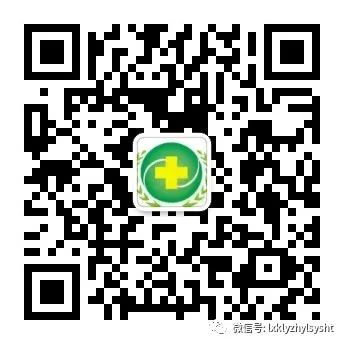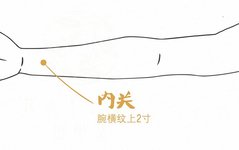The Eight Extraordinary Meridians refer to the Du Mai (Governing Vessel), Ren Mai (Conception Vessel), Chong Mai (Penetrating Vessel), Da Mai (Belt Vessel), Yin Wei Mai (Yin Linking Vessel), Yang Wei Mai (Yang Linking Vessel), Yin Qiao Mai (Yin Heel Vessel), and Yang Qiao Mai (Yang Heel Vessel). Unlike the twelve regular meridians, they do not directly connect to the organs and do not have a paired relationship with the exterior, hence they are referred to as “extraordinary meridians”. In addition to the twelve regular meridians, the human body has a more important balance system, which is the Eight Extraordinary Meridians. The Eight Extraordinary Meridians are our lifelines; as long as you massage the major acupuncture points on these meridians daily, the meridians will be opened, and you will feel a surge of clear Yang energy in your body. The Eight Extraordinary Meridians regulate the accumulation and infusion of Qi and blood in the twelve meridians. Among the Eight Meridians, there are eight representative acupuncture points: Gong Sun (Gong Sun), Nei Guan (Nei Guan), Lin Qi (Lin Qi), Wai Guan (Wai Guan), Shen Mai (Shen Mai), Hou Xi (Hou Xi), Lie Que (Lie Que), and Zhao Hai (Zhao Hai). Each acupuncture point is like a “nuclear reactor”; treating one can affect a large area. 1. Nei Guan: Nourishing Beauty and Heart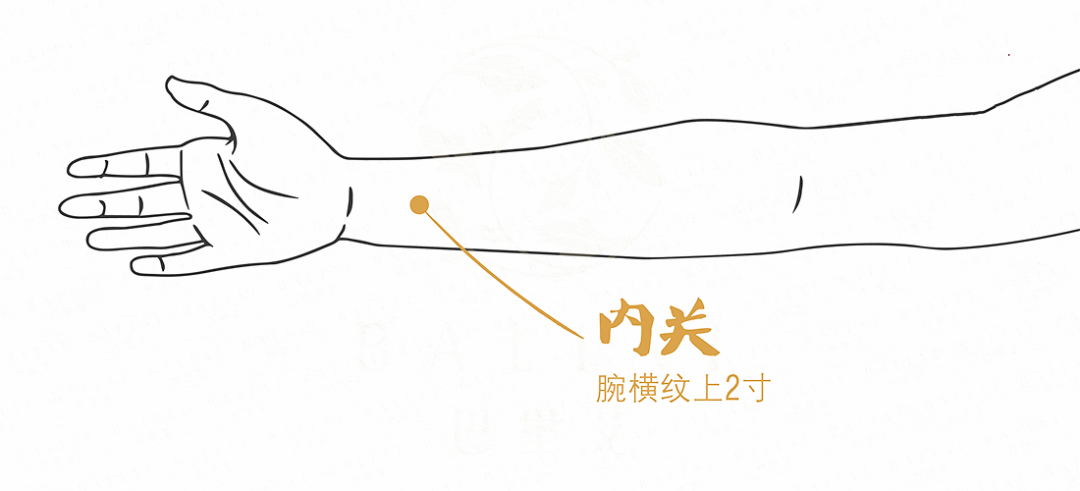 Many women between the ages of 40 and 50 often experience discomfort such as palpitations, shortness of breath, and night sweats. Hospitals may not find any specific illness and can only vaguely diagnose it as menopausal syndrome or sub-health. According to ancient wisdom, when women reach this age, their bodies are generally in a state of decline, with aging beginning from the Yangming Meridian, gradually leading to a decline in the Qi and blood of the three Yang meridians. The head is where all Yang converges; if Qi and blood cannot reach the face, wrinkles and spots will appear. A person’s beauty is closely related to Qi and blood. The heart governs the spirit, and its radiance is reflected in the face. The spirit of the heart relies on Qi and blood for nourishment; when Qi and blood are sufficient, it naturally reflects on the face. Therefore, women should first nourish the heart to enhance their beauty. The Nei Guan point belongs to the Pericardium Meridian, connects with the Ren Mai, and is one of the intersection points of the Eight Meridians. The true efficacy of the Nei Guan point lies in its ability to open the internal mechanisms of the body, benefiting Qi and blood, calming the spirit, and enhancing beauty. The Nei Guan point is easy to locate; it is on the inner side of the arm, two inches above the wrist crease. When locating the point, make a loose fist and place it palm-up; use the index, middle, and ring fingers of the other hand to align with the wrist crease, and the point where the index finger touches is the Nei Guan point. The benefit of this point for health is that it can be pressed and rubbed anytime and anywhere, with a slight sensation of soreness being ideal. 2. Wai Guan: The “Clever Ear Point”
Many women between the ages of 40 and 50 often experience discomfort such as palpitations, shortness of breath, and night sweats. Hospitals may not find any specific illness and can only vaguely diagnose it as menopausal syndrome or sub-health. According to ancient wisdom, when women reach this age, their bodies are generally in a state of decline, with aging beginning from the Yangming Meridian, gradually leading to a decline in the Qi and blood of the three Yang meridians. The head is where all Yang converges; if Qi and blood cannot reach the face, wrinkles and spots will appear. A person’s beauty is closely related to Qi and blood. The heart governs the spirit, and its radiance is reflected in the face. The spirit of the heart relies on Qi and blood for nourishment; when Qi and blood are sufficient, it naturally reflects on the face. Therefore, women should first nourish the heart to enhance their beauty. The Nei Guan point belongs to the Pericardium Meridian, connects with the Ren Mai, and is one of the intersection points of the Eight Meridians. The true efficacy of the Nei Guan point lies in its ability to open the internal mechanisms of the body, benefiting Qi and blood, calming the spirit, and enhancing beauty. The Nei Guan point is easy to locate; it is on the inner side of the arm, two inches above the wrist crease. When locating the point, make a loose fist and place it palm-up; use the index, middle, and ring fingers of the other hand to align with the wrist crease, and the point where the index finger touches is the Nei Guan point. The benefit of this point for health is that it can be pressed and rubbed anytime and anywhere, with a slight sensation of soreness being ideal. 2. Wai Guan: The “Clever Ear Point”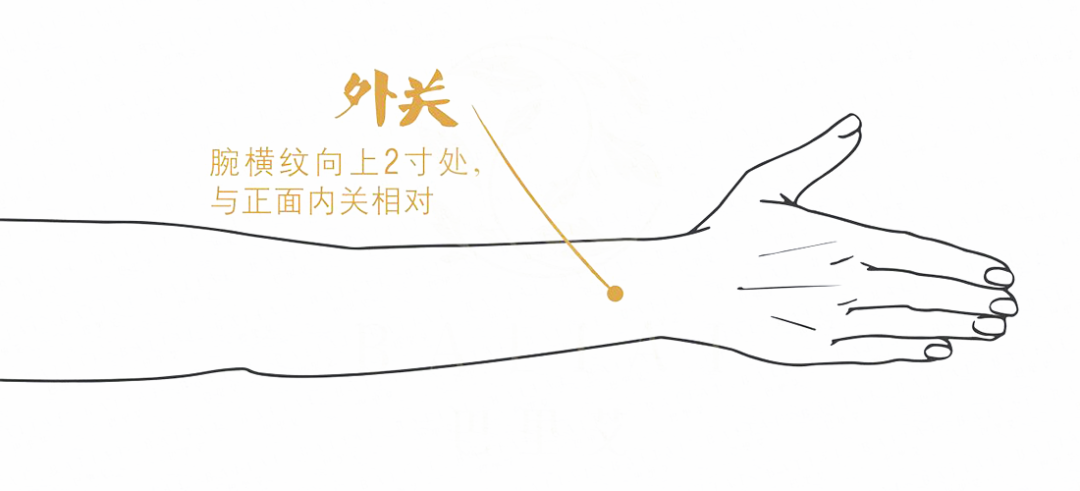 Traditional medicine believes that temporary hearing problems are manifestations of insufficient Yang energy in the body.What role does the Wai Guan point play in this situation? Massaging the Wai Guan point can enrich the original Yang energy of the San Jiao (Triple Burner) and guide the original Qi to circulate throughout the body. When this point is blocked, it can cause the eardrum to become slack and unable to return to its normal state. Clinically, the Wai Guan point can also be used to treat acute lumbar sprains. A patient around 40 years old once bent down to pick something up and stood up too quickly, resulting in severe back pain. After treatment with acupuncture and massage, while needling both Wai Guan points, he was instructed to perform twisting movements of the waist, and within a few minutes, the back pain completely disappeared, and he could move normally. The Wai Guan point is a connecting point of the San Jiao Meridian, located two inches above the wrist crease, between the radius and ulna, opposite to the Nei Guan point. The Wai Guan point has the effects of dispelling exterior pathogens, relieving wind, and alleviating pain; it is not only effective for acute lumbar sprains but also has good effects on arthritis and cervical spondylosis. 3. Lie Que: Special Treatment for Stiff Neck and Migraine
Traditional medicine believes that temporary hearing problems are manifestations of insufficient Yang energy in the body.What role does the Wai Guan point play in this situation? Massaging the Wai Guan point can enrich the original Yang energy of the San Jiao (Triple Burner) and guide the original Qi to circulate throughout the body. When this point is blocked, it can cause the eardrum to become slack and unable to return to its normal state. Clinically, the Wai Guan point can also be used to treat acute lumbar sprains. A patient around 40 years old once bent down to pick something up and stood up too quickly, resulting in severe back pain. After treatment with acupuncture and massage, while needling both Wai Guan points, he was instructed to perform twisting movements of the waist, and within a few minutes, the back pain completely disappeared, and he could move normally. The Wai Guan point is a connecting point of the San Jiao Meridian, located two inches above the wrist crease, between the radius and ulna, opposite to the Nei Guan point. The Wai Guan point has the effects of dispelling exterior pathogens, relieving wind, and alleviating pain; it is not only effective for acute lumbar sprains but also has good effects on arthritis and cervical spondylosis. 3. Lie Que: Special Treatment for Stiff Neck and Migraine Stiff neck is something almost everyone has experienced, and it can be quite painful.Stiff neck can also be an early warning sign of cervical spine issues; those who frequently experience stiff necks should take preventive measures, as it often leads to cervical spondylosis. The Lie Que point has unique effects in preventing cervical spondylosis. On the human body, the Lie Que point serves as a tool for repairing head-related ailments. According to the Huang Di Nei Jing (Yellow Emperor’s Inner Canon), the Lie Que point primarily treats migraines, headaches, and stiff neck.In the Great Compendium of Acupuncture and Moxibustion, there is a well-known verse about the four major points, which states:“For neck and head ailments, seek the Lie Que.”It indicates that ailments above the neck can be treated and regulated using this point. The Lie Que point is easy to locate, situated 1.5 inches above the wrist crease, on the radial styloid process. To locate the point, cross the thumbs of both hands, and the depression where the fingertips touch is the point. The technique for using the Lie Que point mainly involves flicking. 4. Hou Xi: Treatment for Cervical and Lumbar Spine Disorders
Stiff neck is something almost everyone has experienced, and it can be quite painful.Stiff neck can also be an early warning sign of cervical spine issues; those who frequently experience stiff necks should take preventive measures, as it often leads to cervical spondylosis. The Lie Que point has unique effects in preventing cervical spondylosis. On the human body, the Lie Que point serves as a tool for repairing head-related ailments. According to the Huang Di Nei Jing (Yellow Emperor’s Inner Canon), the Lie Que point primarily treats migraines, headaches, and stiff neck.In the Great Compendium of Acupuncture and Moxibustion, there is a well-known verse about the four major points, which states:“For neck and head ailments, seek the Lie Que.”It indicates that ailments above the neck can be treated and regulated using this point. The Lie Que point is easy to locate, situated 1.5 inches above the wrist crease, on the radial styloid process. To locate the point, cross the thumbs of both hands, and the depression where the fingertips touch is the point. The technique for using the Lie Que point mainly involves flicking. 4. Hou Xi: Treatment for Cervical and Lumbar Spine Disorders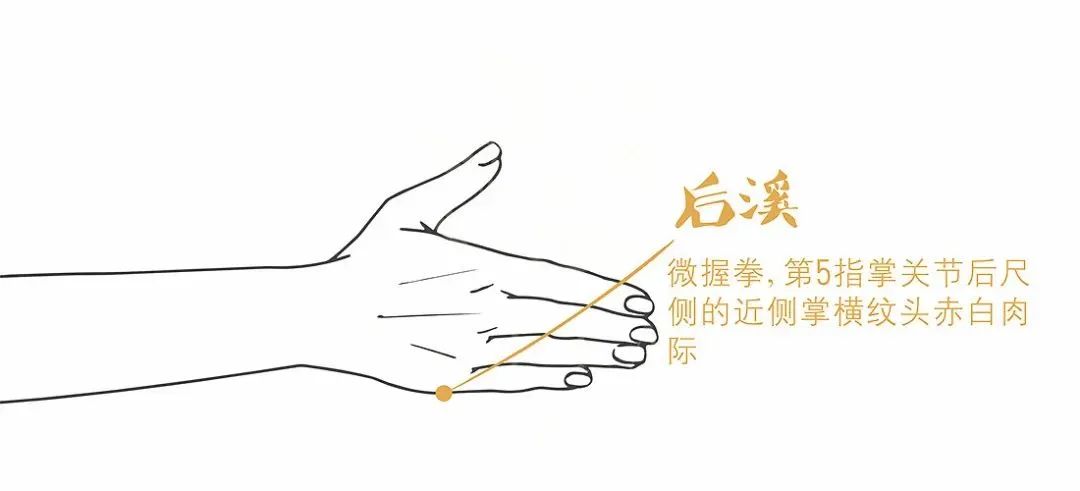 How to find the Hou Xi point? Make a fist, and the point is located at the distal transverse crease behind the fifth finger joint (i.e., the end of the transverse crease behind the fist). If you are sitting in front of a computer, you can place the Hou Xi points of both hands on the edge of the table and use the wrist joints to roll your hands back and forth easily to achieve a stimulating effect. During the rolling, there will be a slight sensation of soreness. Just take three to five minutes each day to move this area, and consistently doing so will have very good effects on the cervical and lumbar spine. 5. Zhao Hai: Treatment for Throat Pain
How to find the Hou Xi point? Make a fist, and the point is located at the distal transverse crease behind the fifth finger joint (i.e., the end of the transverse crease behind the fist). If you are sitting in front of a computer, you can place the Hou Xi points of both hands on the edge of the table and use the wrist joints to roll your hands back and forth easily to achieve a stimulating effect. During the rolling, there will be a slight sensation of soreness. Just take three to five minutes each day to move this area, and consistently doing so will have very good effects on the cervical and lumbar spine. 5. Zhao Hai: Treatment for Throat Pain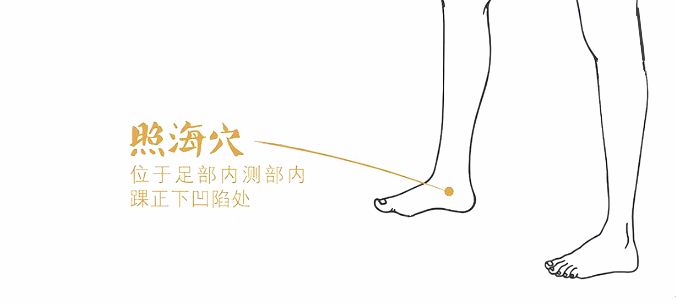 For throat pain, massaging the Zhao Hai point can yield excellent results, as the Zhao Hai point belongs to the Yin Qiao Mai and intersects with the Kidney Meridian, making it one of the key intersection points of the Eight Meridians. It has the functions of nourishing the kidneys, clearing heat, and regulating the three burners, providing both nourishment and heat-clearing effects. Sun Simiao in the Qian Jin Yao Fang (Essential Prescriptions Worth a Thousand Gold) referred to this point as “Lou Yin”; if there is an issue with this point, it can lead to a decrease in kidney water, resulting in kidney Yin deficiency and causing deficiency heat to rise. Therefore, whenever we feel discomfort in the chest, dry throat, hoarseness, or even chronic pharyngitis, we can press this point, which not only has the effect of nourishing the kidneys and clearing heat but also helps to smooth the functions of the three burners. To locate the point, align the soles of both feet, and there is a small depression below the inner ankle, which is where the point is located (see the above image). When massaging this point, keep your mouth closed and do not speak; you should feel saliva in your mouth and swallow it down. Generally, after pressing for 3 to 5 minutes, you will feel saliva in your throat, and the pain will immediately alleviate. Keeping your mouth closed is to facilitate the upward movement of saliva to moisten the throat, which is what the ancients referred to as the “swallowing saliva method.” Massaging the Zhao Hai point will stimulate the essence and Qi in the kidneys, allowing fluids to rise and moisten the throat, and the deficiency heat will be nourished by the kidney water, thus alleviating throat pain naturally. 6. Shen Mai: A Pure Yang Remedy for Cold Bodies
For throat pain, massaging the Zhao Hai point can yield excellent results, as the Zhao Hai point belongs to the Yin Qiao Mai and intersects with the Kidney Meridian, making it one of the key intersection points of the Eight Meridians. It has the functions of nourishing the kidneys, clearing heat, and regulating the three burners, providing both nourishment and heat-clearing effects. Sun Simiao in the Qian Jin Yao Fang (Essential Prescriptions Worth a Thousand Gold) referred to this point as “Lou Yin”; if there is an issue with this point, it can lead to a decrease in kidney water, resulting in kidney Yin deficiency and causing deficiency heat to rise. Therefore, whenever we feel discomfort in the chest, dry throat, hoarseness, or even chronic pharyngitis, we can press this point, which not only has the effect of nourishing the kidneys and clearing heat but also helps to smooth the functions of the three burners. To locate the point, align the soles of both feet, and there is a small depression below the inner ankle, which is where the point is located (see the above image). When massaging this point, keep your mouth closed and do not speak; you should feel saliva in your mouth and swallow it down. Generally, after pressing for 3 to 5 minutes, you will feel saliva in your throat, and the pain will immediately alleviate. Keeping your mouth closed is to facilitate the upward movement of saliva to moisten the throat, which is what the ancients referred to as the “swallowing saliva method.” Massaging the Zhao Hai point will stimulate the essence and Qi in the kidneys, allowing fluids to rise and moisten the throat, and the deficiency heat will be nourished by the kidney water, thus alleviating throat pain naturally. 6. Shen Mai: A Pure Yang Remedy for Cold Bodies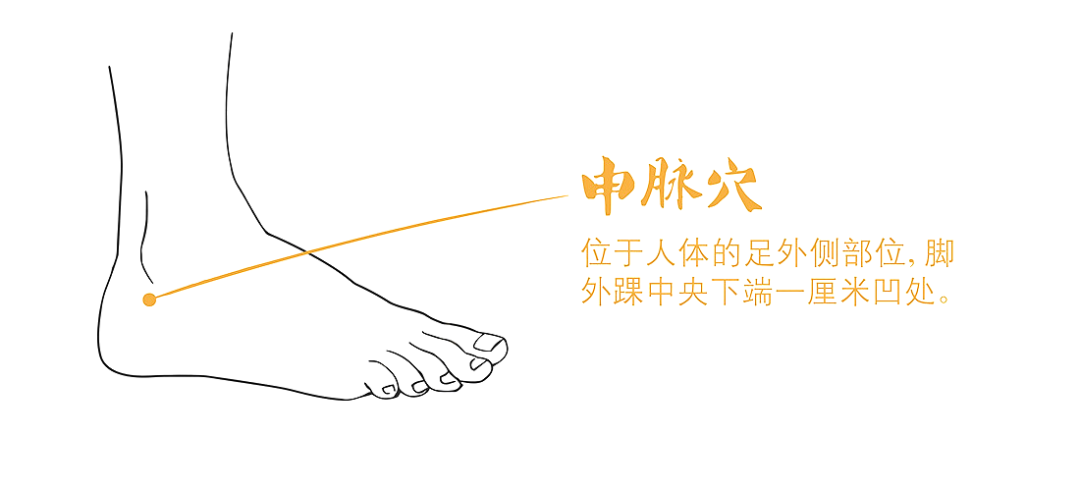 ”Stiffness in the waist and back, leg pain” is a clear sign of the bladder meridian being affected by cold evil energy. Since the Yang Qiao Mai connects to the bladder meridian, the Shen Mai point itself is an important point on the bladder meridian. Therefore, Shen Mai is the pure Yang point; using this point can dispel internal cold evil and allow Yang energy to reach the summit, balancing the body and enabling agile movement. The Shen Mai point is an important intersection point of the Yang Qiao and Tai Yang Bladder Meridians, and its location is also very simple, found in the depression directly below the outer ankle bone. When the body is affected by cold evil, it tends to curl up and shiver, which in TCM is referred to as “contraction and retraction”; the Shen Mai point has the meaning of extending the meridians, quickly mobilizing the body’s Yang energy, and when Yang energy is sufficient, the cold evil will disperse. 7. Gong Sun: Alleviating Dysmenorrhea and Spleen-Stomach Disorders
”Stiffness in the waist and back, leg pain” is a clear sign of the bladder meridian being affected by cold evil energy. Since the Yang Qiao Mai connects to the bladder meridian, the Shen Mai point itself is an important point on the bladder meridian. Therefore, Shen Mai is the pure Yang point; using this point can dispel internal cold evil and allow Yang energy to reach the summit, balancing the body and enabling agile movement. The Shen Mai point is an important intersection point of the Yang Qiao and Tai Yang Bladder Meridians, and its location is also very simple, found in the depression directly below the outer ankle bone. When the body is affected by cold evil, it tends to curl up and shiver, which in TCM is referred to as “contraction and retraction”; the Shen Mai point has the meaning of extending the meridians, quickly mobilizing the body’s Yang energy, and when Yang energy is sufficient, the cold evil will disperse. 7. Gong Sun: Alleviating Dysmenorrhea and Spleen-Stomach Disorders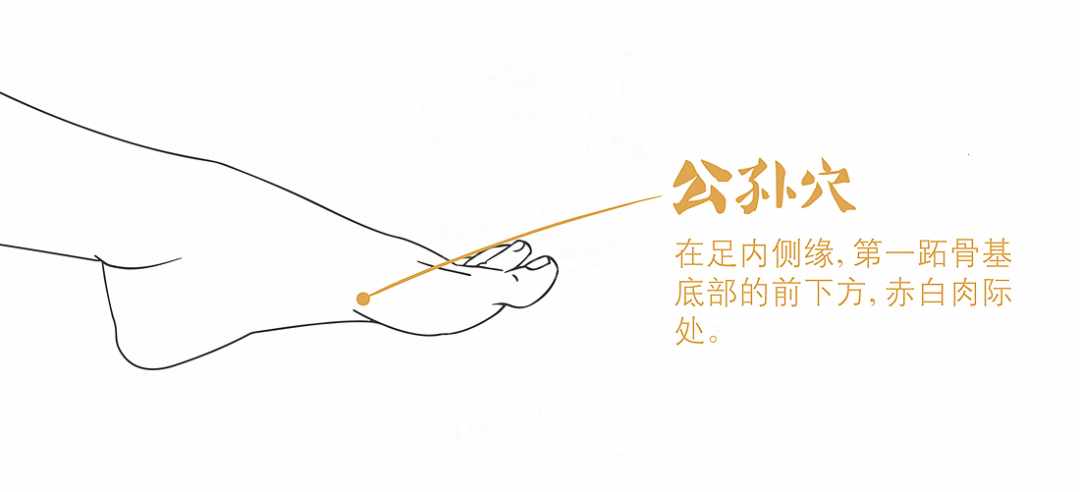 Gong Sun is the connecting point of the Spleen Meridian, belonging to the spleen and connecting to the stomach, and it directly communicates with the Chong Mai located in the chest and abdomen, thus it has the effect of treating various disorders of the spleen, stomach, and abdominal area. Medicine believes that the treatment of all gynecological diseases should start with the spleen and stomach, especially for menstrual irregularities, where the stomach should be adjusted first. The spleen governs blood and is responsible for transformation. If the spleen and stomach are deficient and cold, they cannot transform and transport dampness, leading to dysmenorrhea, which may also be accompanied by symptoms such as vomiting, nausea, and headaches. Women with dysmenorrhea can benefit from frequently massaging the Gong Sun point.The Gong Sun point is located on the inner edge of the foot; I generally consider the Gong Sun point as a region, located behind the big toe, where there is a large metatarsal bone. Press along the inner side of this bone until you reach the point where you feel the most soreness or discomfort; that is your personal Gong Sun point. 8. Lin Qi: Elevating the Body’s Shao Yang Qi
Gong Sun is the connecting point of the Spleen Meridian, belonging to the spleen and connecting to the stomach, and it directly communicates with the Chong Mai located in the chest and abdomen, thus it has the effect of treating various disorders of the spleen, stomach, and abdominal area. Medicine believes that the treatment of all gynecological diseases should start with the spleen and stomach, especially for menstrual irregularities, where the stomach should be adjusted first. The spleen governs blood and is responsible for transformation. If the spleen and stomach are deficient and cold, they cannot transform and transport dampness, leading to dysmenorrhea, which may also be accompanied by symptoms such as vomiting, nausea, and headaches. Women with dysmenorrhea can benefit from frequently massaging the Gong Sun point.The Gong Sun point is located on the inner edge of the foot; I generally consider the Gong Sun point as a region, located behind the big toe, where there is a large metatarsal bone. Press along the inner side of this bone until you reach the point where you feel the most soreness or discomfort; that is your personal Gong Sun point. 8. Lin Qi: Elevating the Body’s Shao Yang Qi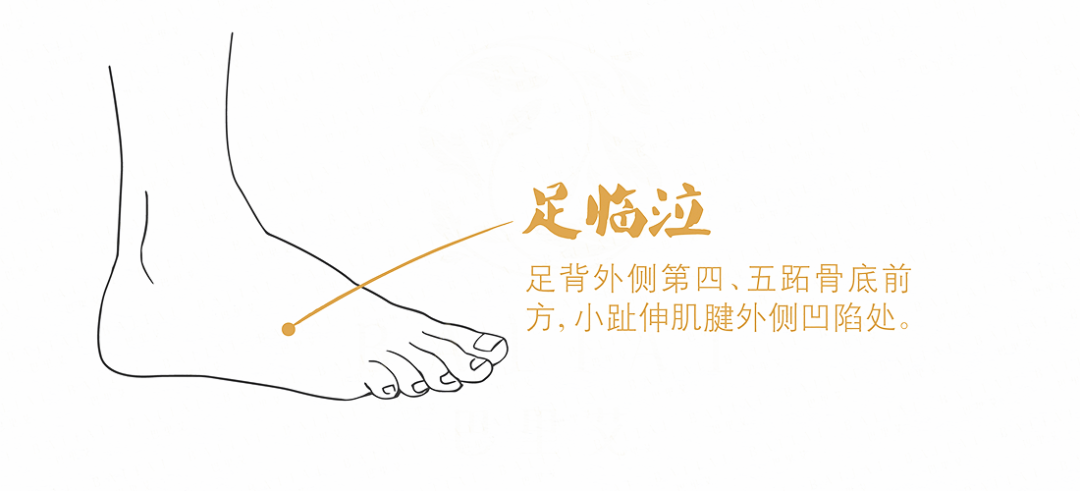 The Lin Qi point is one of the main points on the Gallbladder Meridian, connecting with the Chong Mai, and it is a wonderful point that regulates two meridians with one point. The Chong Mai runs around the human body at the level of the navel, like a jade belt tying the body together, enhancing the connection of Qi and blood flow between the meridians, making it a very important health meridian for the human body. When using this point, you can adopt a sitting position with your legs curled up; it is located on the outer side of the foot, in the gap between the fourth and fifth toes. The Lin Qi point primarily elevates the body’s Shao Yang Qi and disperses the stagnant Qi of the liver and gallbladder; frequent pressing can yield better results than professional foot therapy.
The Lin Qi point is one of the main points on the Gallbladder Meridian, connecting with the Chong Mai, and it is a wonderful point that regulates two meridians with one point. The Chong Mai runs around the human body at the level of the navel, like a jade belt tying the body together, enhancing the connection of Qi and blood flow between the meridians, making it a very important health meridian for the human body. When using this point, you can adopt a sitting position with your legs curled up; it is located on the outer side of the foot, in the gap between the fourth and fifth toes. The Lin Qi point primarily elevates the body’s Shao Yang Qi and disperses the stagnant Qi of the liver and gallbladder; frequent pressing can yield better results than professional foot therapy.
